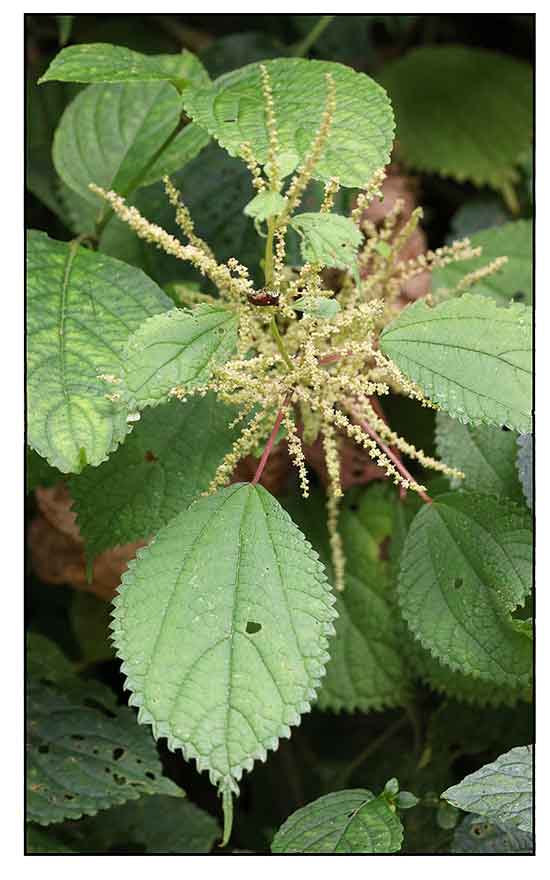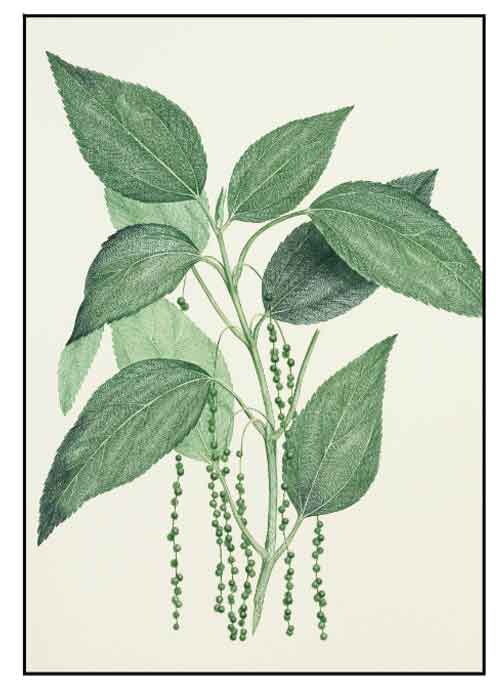
Family • Urticaceae
Haramay
Boehmeria virgata (G.Forst) Guill.
FALSE NETTLE / LARGE-SPIKE RAMIE
| Scientific names | Common names |
| Boehmeria platyphylla var. virgata (G.Forst.) Wedd. | Haramay (Indonesia) |
| Boehmeria taitensis Wedd. | False nettle (Engl.) |
| Boehmeria virgata (G.Forst.) Guill. | Large-spike ramie (Engl.) |
| Urtica virgata G.Forst. | White false nettle (Engl.) |
| Accepted infraspecifics (15) | |
| Bv var. austroqueenslandica (Domin) Friis & Wilmot-Dear | |
| Bv var. canescens (Wedd.) Friis & Wilmot-Dear | |
| Bv var. densiglomerata (W.T.Wang) Friis & Wilmot-Dear | |
| Bv var. longissima (Hook.f.) Friis & Wilmot-Dear | |
| Bv subsp. macrophylla (Hornem.) Friis & Wilmot-Dear | |
| Bv var. macrostachya (Wight) Friis & Wilmot-Dear | |
| Bv var. maxima Friis & Wilmot-Dear | |
| Bv var. minuticymosa Acharya, Friis & Wilmot-Dear | |
| Bv var. rotundifolia (D.Don) Friis & Wilmot-Dear | |
| Bv var. scabrella (Dalzell & A.Gibson) Friis & Wilmot-Dear | |
| Bv var. strigosa (W.T.Wang) Friis & Wilmot-Dear | |
| Bv var. sumatrana (Miq.) Friis & Wilmot-Dear | |
| Bv var. tomentosa (Wedd.) Friis & Wilmot-Dear | |
| Bv var. velutina Friis & Wilmot-Dear | |
| Boehmeria viragata subsp. virgata | |
| Boehmeria caudata var. celebica (Blume) J.J.Sm. | |
| Boehmeria caudata var. pendula J.J.Sm. | |
| Boehmeria celebica (Blume) Blume | |
| Boehmeria erythropod Miq. | |
| Boehmeria huegeliana Blume | |
| Boehmeria microcarpa Wedd. | |
| Boehmeria platyphylla var. celebica (Blume) Wedd. | |
| Boehmeria platyphylla var. marquesensis F.Br. | |
| Boehmeria platyphylla var. microcarpa (Wedd.) Wedd. | |
| Urtica celebica Blume | |
| Boehmeria virgata is an accepted species. KEW: Plants of the World Online | |
| Note: Unable to find a Philippine name, In the meantime, Haramay, an Indonesian name for the plant, is used as plant page title. (Stuart) | |
| Other vernacular names |
| INDIA: Dieng sohkhra (Khasi), Uipa-chhawhchhi (Mizo). |
| INDONESIA: Parang romang (Sulawesi), Haramay (West Java). |
• Large-Spike Ramie (Boehmeria vrigata var. macrostachya) is a perennial herb or subshrub, growing up to 2 m tall. Leaves are papery, widely varying in shape, proportions and number of teeth, ovate to rhombic-ovate or elliptic, medium or large, 10–20 by 7–16 cm, usually relatively broad, length 1.5–2 × width; marginal teeth 25–50 either side. Inflorescence-bearing axes are 10–50 cm long, pendulous, unbranched or with a few long branches close to base or sometimes male with lateral branches throughout length and erect with pendent tip. (Flowers of India) Distribution Constituents
Studies Availability |
July 2025
![]()
 |
| Â Â Â Â Â Â Â Â Â Â Â Â Â Â Â Â Â Â Â Â Â Â Â Â Â PHOTOS / ILLUSTRATIONS |
| IMAGE SOURCE: Boehmeria macrophyla / © Phuentsho / Some rights reserved / CC BY-NC-SA / Click on image or link to go to source page / iNaturalist |
| OTHER IMAGE SOURCE: Illustration: Boehmeria virgata (G.Forst.) Guill. / Sydney Parkinson (artist) / Engraving by Gabriel Smith, printed a la poupee by Alecto Historical Editions / Print no longer available / Click on image to go to source page / TF: Type & Forme |
Additional
Sources and Suggested Readings |
• |
DOI: It is not uncommon for links on studies/sources to change. Copying and pasting the information on the search window or using the DOI (if available) will often redirect to the new link page. (Citing and Using a (DOI) Digital Object Identifier) |
| Â Â Â Â Â Â Â Â Â Â Â Â Â Â Â Â Â Â Â Â Â Â Â Â Â Â Â Â Â Â List of Understudied Philippine Medicinal Plants |
| Â Â Â Â Â Â Â Â Â Â Â Â Â Â Â Â Â Â Â Â Â New plant names needed The compilation now numbers over 1,500 medicinal plants. While I believe there are hundreds more that can be added to the collection, they are becoming more difficult to find. If you have a plant to suggest for inclusion, native or introduced, please email the info: scientific name (most helpful), local plant name (if known), any known folkloric medicinal use, and, if possible, a photo. Your help will be greatly appreciated. |
• |
 |
• |



